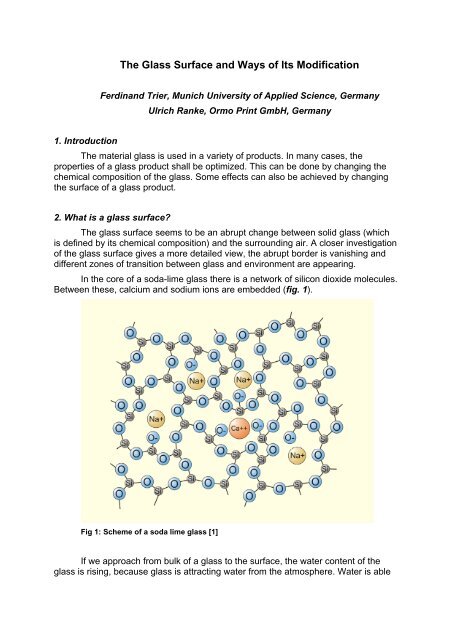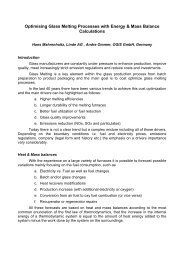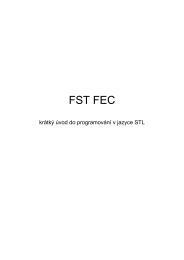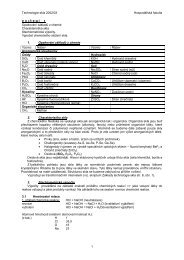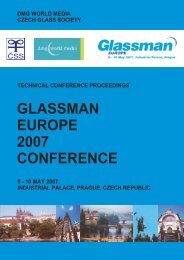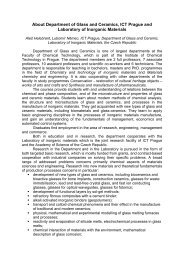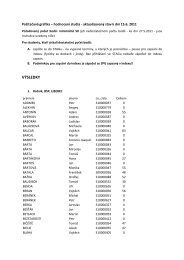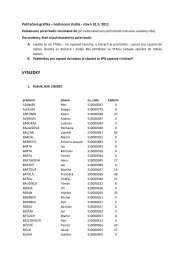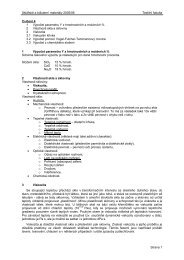The Glass Surface and Ways of Its Modification
The Glass Surface and Ways of Its Modification
The Glass Surface and Ways of Its Modification
You also want an ePaper? Increase the reach of your titles
YUMPU automatically turns print PDFs into web optimized ePapers that Google loves.
<strong>The</strong> <strong>Glass</strong> <strong>Surface</strong> <strong>and</strong> <strong>Ways</strong> <strong>of</strong> <strong>Its</strong> <strong>Modification</strong><br />
Ferdin<strong>and</strong> Trier, Munich University <strong>of</strong> Applied Science, Germany<br />
Ulrich Ranke, Ormo Print GmbH, Germany<br />
1. Introduction<br />
<strong>The</strong> material glass is used in a variety <strong>of</strong> products. In many cases, the<br />
properties <strong>of</strong> a glass product shall be optimized. This can be done by changing the<br />
chemical composition <strong>of</strong> the glass. Some effects can also be achieved by changing<br />
the surface <strong>of</strong> a glass product.<br />
2. What is a glass surface?<br />
<strong>The</strong> glass surface seems to be an abrupt change between solid glass (which<br />
is defined by its chemical composition) <strong>and</strong> the surrounding air. A closer investigation<br />
<strong>of</strong> the glass surface gives a more detailed view, the abrupt border is vanishing <strong>and</strong><br />
different zones <strong>of</strong> transition between glass <strong>and</strong> environment are appearing.<br />
In the core <strong>of</strong> a soda-lime glass there is a network <strong>of</strong> silicon dioxide molecules.<br />
Between these, calcium <strong>and</strong> sodium ions are embedded (fig. 1).<br />
Fig 1: Scheme <strong>of</strong> a soda lime glass [1]<br />
If we approach from bulk <strong>of</strong> a glass to the surface, the water content <strong>of</strong> the<br />
glass is rising, because glass is attracting water from the atmosphere. Water is able
to break some <strong>of</strong> the connections in the silicon dioxide network <strong>and</strong> further diffuse<br />
from the surface <strong>and</strong> micro-cracks into the glass bulk (fig. 2).<br />
Fig. 2: Typical glass surface before coating<br />
<strong>The</strong> sodium content near the surface may differ from the bulk material,<br />
because sodium is volatile under conditions <strong>of</strong> the heat treatment <strong>of</strong> the glass, so it<br />
may vaporize in some regions <strong>of</strong> the glass, but may also condense in other regions.<br />
At the point, where the network <strong>of</strong> silicon dioxide ends, the network is<br />
continued with chemisorbed water molecules (fig. 3). This chemically absorbed water<br />
film goes over in a physically absorbed water film, which also collects various<br />
adsorbates from the atmosphere, like organic molecules <strong>and</strong> dirt particles.<br />
Fig. 3: Sodium-silicate glass with water film
<strong>The</strong> condition <strong>of</strong> the glass surface depends in a high degree from the history <strong>of</strong><br />
the glass. It is already changed at the manufacturing, but also while the storage <strong>of</strong><br />
the glass. Everybody who is concerned with glass should be aware <strong>of</strong> this fact.<br />
3. Properties how to change the properties <strong>of</strong> a glass surface<br />
<strong>Modification</strong>s at a glass surface can be classified as following:<br />
o methods, which generate a new surface by removing material<br />
from the original surface<br />
o methods, which do not form a new surface, although the original<br />
surface is modified by exchange <strong>of</strong> material<br />
o methods, which generate a new surface by adding additional<br />
matter to the original surface<br />
For these methods, there exists a variety <strong>of</strong> methods (fig. 4 )<br />
Removal <strong>of</strong><br />
material from<br />
surface<br />
Mechanical:<br />
• Grinding<br />
• Polishing<br />
Chemical:<br />
• Etching<br />
Different <strong>Ways</strong> for <strong>Surface</strong> <strong>Modification</strong>s<br />
<strong>Modification</strong> by<br />
material<br />
exchange<br />
Diffusion:<br />
• <strong>Glass</strong> staining<br />
• Chemical<br />
toughening<br />
Fig. 4: <strong>Ways</strong> for surface modification - overview<br />
Addition <strong>of</strong><br />
material to surface<br />
From plasma:<br />
• Ion plating<br />
• PECVD<br />
From gas phase:<br />
• Sputtering<br />
• PVD<br />
• CVD<br />
From liquid/solid<br />
phase:<br />
• Paint<br />
• Ceramic coatings<br />
• Au/Pt/Ag<br />
Coatings<br />
• Sol-gel<br />
• Hybrids
4. <strong>Modification</strong> by removing matter from the original surface<br />
4.1 Mechanically ablating methods<br />
At a mechanically ablating process, little particles are broken out <strong>of</strong> the glass<br />
surface by the impact with a grinding matter. Usual techniques are grinding, polishing<br />
<strong>and</strong> blasting. Mechanically ablated surfaces always become rough, but the grade <strong>of</strong><br />
roughness can be well controlled, so that even optically smooth surfaces are<br />
attainable. Grinding methods are necessary, in case the shape <strong>of</strong> the glass part must<br />
be defined very exactly, e.g. for optical parts.<br />
Blasting is <strong>of</strong>ten used to get a surface with a certain roughness, without<br />
special attention to the mechanical precision (fig. 5). A probable disadvantage <strong>of</strong> a<br />
blasted surface is the high number <strong>of</strong> micro-cracks, which are generated at the<br />
process. Micro-cracks are suspected to weaken the mechanical strength <strong>of</strong> the part.<br />
On the other h<strong>and</strong>, surface frosting by blasting is typically cheaper than by etching.<br />
Fig 5: SEM picture <strong>of</strong> a blasted glass surface<br />
4.2 Chemically ablating methods<br />
Ablating by etching will typically have a smoothening effect to the surface. This<br />
polishing is <strong>of</strong>ten the motivation for the procedure. Another motivation is to replace<br />
the original surface, which is probably undefined, soiled or affected with micro-cracks<br />
with a newly created surface. <strong>The</strong> effect is a surface cleaning.
It is also possible to create a rough surface by etching. With acid frosting little<br />
crystals are settling at the glass surface <strong>and</strong> stop the acid attack at the covered<br />
areas, while the etching is between the crystals is not obstructed. <strong>The</strong> surface<br />
structure, which is generated by that, is an image <strong>of</strong> the crystals (fig. 6 ).<br />
Compared to blasted surfaces, acid frosted surfaces have a very fine structure<br />
<strong>and</strong> a smooth touch.<br />
Fig. 6: SEM picture <strong>of</strong> an acid frosted surface<br />
5. <strong>Modification</strong> <strong>of</strong> the existing glass surface<br />
Behind this term hide two traditional techniques, the glass staining <strong>and</strong><br />
chemical toughening. Also newer techniques, which influence the surface energy <strong>of</strong><br />
glass, belong to this category.<br />
5.1 <strong>Glass</strong> staining<br />
For glass staining, silver is brought in the glass over a surface diffusion<br />
process. <strong>The</strong> yellow to orange-brown colour is generated by the formation <strong>of</strong> silver<br />
clusters. <strong>The</strong> diffusion process is conducted at high temperature for several hours<br />
from a silver containing paste, which was applied to the glass.
5.2 Chemical toughening <strong>of</strong> glass<br />
Chemical toughening <strong>of</strong> glass is also a diffusion process. Sodium ions, which<br />
are present in the glass are partially replaced by potassium ions. Due to the higher<br />
diameter <strong>of</strong> the potassium ions, the volume <strong>of</strong> the potassium enriched volume is<br />
increased. Resulting mechanical stress leads to a higher mechanical strength <strong>of</strong> the<br />
part, like with thermal tempered glass. <strong>The</strong> process is conducted at high temperature<br />
by immersing the glass part into a molten potassium salt (fig. 7).<br />
Fig. 7: Scheme <strong>of</strong> chemical strengthening:<br />
7a: before ion exchange (left) 7b: after ion exchange (right)<br />
6. <strong>Modification</strong> by adding matter to the original surface (coating)<br />
For the surface modification by coating, very different techniques are in use.<br />
<strong>The</strong> field can be roughly distinguished into 4 sections.<br />
6.1 Physical vapour deposition (PVD)<br />
For this process the coating material is evaporated in high vaccum by high<br />
temperature <strong>and</strong> condensated at the glass surface (fig. 8). <strong>The</strong> growing rate <strong>of</strong> the<br />
layer can be controlled by special measurement equipment. Often more than one<br />
coating are applied. So mirrors or antireflection coatings can be applied by a<br />
sequence <strong>of</strong> coatings with high <strong>and</strong> low refraction index. PVD coatings are used for<br />
antireflection coatings <strong>and</strong> metal oxide vaporized mirrors.<br />
6.2 Sputtering<br />
Sputtering is a high vacuum process as well, with a certain similarity to PVD.<br />
In opposite to PVD, the coating material is not thermally evaporated, but released by<br />
ion bombardment <strong>of</strong> a target. <strong>The</strong> matter, which is released from the target, is settling<br />
on the glass surface (fig. 9). Sputtering is more versatile compared to PVD, it is e.g.<br />
also possible to sputter materials with a very low vapour pressure.<br />
Sputtering meanwhile became the st<strong>and</strong>ard procedure for low-E coatings for window<br />
glass.
Fig. 8: Scheme <strong>of</strong> an Electron beam physical vapour deposition (EBPVD) plant<br />
Fig. 9 Scheme <strong>of</strong> sputter deposition
6.3 Chemical Vapour deposition (CVD)<br />
<strong>The</strong> CVD process is characterized by the fact, that a solid coating is formed<br />
from one or more vaporized chemical precursors (fig. 10). Depending on the nature<br />
<strong>of</strong> the chemical reaction, such a process may also be conducted at atmospheric<br />
pressure.<br />
A typical PVD process a atmospheric pressure is the hot-end coating <strong>of</strong><br />
container glass. Here a volatile, tin-organically substance is reduced at the hot glass<br />
surface to tin oxide.<br />
Fig. 10: Hot-end coating <strong>of</strong> container glass<br />
6.4.1 Wet coatings.<br />
For wet coatings, a paste or liquid is applied to the glass surface. By either a<br />
chemical <strong>and</strong> / or physical process the wet layer is hardened to a coating. Depending<br />
on the process, the coating needs an additional curing process to achieve the final<br />
durability.<br />
6.4.1.1 Inorganic coatings<br />
Inorganic coatings are known under the name „ceramic coatings” or „Sol-Gel“.<br />
Inorganic coatings are applied as fluid or paste. A first drying is typically conducted<br />
by solvent evaporation. To achieve full hardness, these coatings need to be fired at a<br />
high temperature, the upper temperature is typically limited by the properties <strong>of</strong> the<br />
basic glass.
6.4.1.1.1 Ceramic coatings<br />
Ceramic coatings are mostly a dispersion <strong>of</strong> a glass powder, which is melting<br />
on the basic glass while curing. It is necessary that the transformation temperature <strong>of</strong><br />
the coating is below the transformation temperature <strong>of</strong> the basic glass. Colour effects<br />
can be achieved with colouring metal salts. Ceramic paints give durable <strong>and</strong> robust<br />
coatings.<br />
A special case is the precipitation <strong>of</strong> precious metals (gold, platinum) on glass.<br />
Such formulations are based on metal salts, which are reduced to the metal at firing.<br />
Ceramic coatings have a wide field <strong>of</strong> application for flat glass as well as for<br />
hollow glass. A typical application is the black print around the rim <strong>of</strong> a car<br />
windshield. Here the gluing <strong>of</strong> the window shall be covered – not only for nice<br />
appearance – but also to protect the glue from the harmful influence <strong>of</strong> sunlight.<br />
6.4.1.1.2 Sol-gel<br />
<strong>The</strong> classical sol-gel method gives inorganic coatings as well. <strong>The</strong>se are<br />
formed from a colloid by evaporation <strong>of</strong> the liquid phase. <strong>The</strong> solid phase <strong>of</strong> the<br />
colloid is synthesized from a solution <strong>of</strong> precursors (fig. 11).<br />
Fig. 11: Basic chemical reactions for Silica deposition by sol-gel<br />
Usually oxide coatings can be generated with sol-gel, typical are coatings<br />
made <strong>of</strong> silicon oxide.<br />
<strong>The</strong> coatings are massively shrinking while the curing process, which is a<br />
result <strong>of</strong> the loss <strong>of</strong> the liquid phase. This is why only thin layers are possible, thick<br />
layers are cracking.<br />
Sol-gel is <strong>of</strong>ten used for interference coatings.
6.4.1.2 Organic coatings<br />
<strong>Glass</strong> can be decorated with organic paints as well. Based on usual industrial<br />
coatings such coatings are modified for glass coating. One- ore two-component<br />
systems or powder coatings are usual. Some important quality criteria for an organic<br />
glass paint are:<br />
o good adhesion to glass (even under influence <strong>of</strong> water)<br />
o high gloss<br />
o high scratch resistance<br />
o good levelling<br />
o high transparency<br />
Due to the easy application <strong>and</strong> curing, organic paints are <strong>of</strong>ten used for glass<br />
decorations. <strong>The</strong> durability <strong>of</strong> ceramic coatings is generally not obtained by organic<br />
coatings.<br />
6.4.1.3 Hybrid coatings<br />
Hybrid coatings were developed from sol-gels to overcome the limitations to<br />
layer thickness as well as to improve chemical resistance. Hybrids contain inorganic<br />
as well as organic matter. So the shrinking <strong>of</strong> the coating is reduced which makes<br />
thicker coatings possible, compared to sol-gels. Due to the thicker layers, colorants<br />
Fig. 12: SEM view on a broken glass, which has previously been coated with a sol-gel hybrid
can be introduced in the coating, so transparent or opaque decoration coatings are<br />
possible. Typical decoration coatings have a thickness between 1 <strong>and</strong> 10 micron. So<br />
hybrids are still thinner than organic coatings. That does not only result in economical<br />
advantages, also the appearance pr<strong>of</strong>its from the thin layers (fig. 12).<br />
7. Examples for application techniques with wet coatings<br />
For the surface removing techniques, as well as for the vacuum techniques,<br />
the process is rather defined by the technical procedure. For the wet coatings,<br />
everything is possible, which leads to a success. In the following section, some<br />
application techniques for wet coatings shall be introduced.<br />
7.1 St<strong>and</strong>ard techniques<br />
St<strong>and</strong>ard techniques for coating are dip coating (fig. 13), spray application<br />
(fig. 14) <strong>and</strong> brush painting (fig. 15). Dip coating <strong>and</strong> spray coating can be<br />
automated easily und are <strong>of</strong>ten used in mass production.<br />
7.2 Felt pen<br />
Application by felt pen has – compared to brush painting – the advantage, that<br />
the painting can be done continuously, because the paint flow works automatically.<br />
Lines, which fit to the width <strong>of</strong> the tip are easier to draw than with a brush<br />
Fig 13: dip coating
Fig 14: spray coating<br />
Fig 15: brush coating<br />
7.3 Coating <strong>of</strong> bulk material<br />
For bulk material a solvent based system can be applied. <strong>The</strong> bulk material (grains or<br />
beads) are intensively mixed with the paint, so that the paint spreads equally over the
whole surface <strong>of</strong> the bulk material. After that, the solvent is blown out, so the paint is<br />
fixed <strong>and</strong> can be cured afterwards (fig. 16). It is important, that the paint spreads<br />
easily over the material <strong>and</strong> that the paint does not glue the material together.<br />
Fig. 16: Paint application on glass beads<br />
7.4 Inside-coating <strong>of</strong> tubes Innenbeschichtung von Röhren<br />
An interesting<br />
technique is the<br />
inside coating <strong>of</strong><br />
tubes with a<br />
homogenous<br />
coating. This can be<br />
done in analogy to a<br />
dip coating process,<br />
by filling the tubes<br />
with paint <strong>and</strong><br />
running it out after<br />
that. It is not trivial to<br />
get homogenous<br />
layers over the<br />
length <strong>of</strong> the tube.<br />
For solvent based<br />
paints, a defined<br />
ventilation <strong>of</strong> the<br />
tube is helpful to fix<br />
the coating (fig. 17).<br />
Fig. 17: inside coating <strong>of</strong> glass tubes
7.5 Digital printing<br />
For hybrid paints, two interesting digital printing techniques have been<br />
developed.<br />
7.5.1 Airbrush print<br />
For airbrush printing, the paint is sprayed to the glass with digitally controlled<br />
nozzles. Colour generation works by sequential application <strong>of</strong> the basic colours cyan,<br />
magenta, yellow <strong>and</strong> black. <strong>The</strong> pictures are created pixel by pixel. <strong>The</strong> resolution is<br />
42 dpi (dots per inch) (fig 18). <strong>The</strong> maximum size <strong>of</strong> the print is 3.5 x 6 metre.<br />
Fig. 18: Print on glass with Ormojet Airbrush hybrid paint, printed on a TCG<br />
Michelangelo printer<br />
7.5.2 Ink-jet Print<br />
<strong>The</strong> viscosity <strong>of</strong> the hybrid ink can be made so low, that it can be printed even<br />
with an ink-jet printer (fig. 19). For ink-jet, a piezoelectric printing head can be used.<br />
Often Epson heads are used, which make a resolution <strong>of</strong> 1440 dpi possible. <strong>The</strong> size<br />
<strong>of</strong> a single ink droplet is 2 picolitre. With hybrid paints, prints with good resistance on<br />
glass are possible. <strong>The</strong> ink can be coloured either with dies or with pigments. A white<br />
ink is also available.<br />
At the moment, different flat-bed plotters are <strong>of</strong>fered, which allows prints on<br />
glass with a size up to 2.5 x 3.5 m. For cylindrical hollow glass, the first prototypes<br />
wave been successfully tested <strong>and</strong> we expect in future the development <strong>of</strong> printers<br />
for printing on irregular shapes.
Fig. 19: Inkjet print on a glass plate with Ormojet hybrid ink, printed with a Technoplot<br />
printer<br />
8. Summary<br />
Many properties <strong>of</strong> a glass object are determined by the properties <strong>of</strong> its<br />
surface. This is why many techniques have been developed to change the original<br />
glass surface to make the glass object either more decorative or to improve its<br />
functionality. This paper gives a short overview <strong>of</strong> the most important techniques <strong>of</strong><br />
surface modification techniques on glass.<br />
9. References<br />
[1] Hüttentechnische Vereinigung der Deutschen Glasindustrie (HRSG): „Festigkeit<br />
von Glas – Grundlagen und Prüfverfahren“ Frankfurt/Main, 1987<br />
[2] H.K. Pulker: „Coatings on glass“, Amsterdam 1984<br />
Pr<strong>of</strong>. Dr.-Ing. Ferdin<strong>and</strong> Trier, Munich University <strong>of</strong> Applied Sciences, Laboratory for<br />
Measurement Techniques Consultation for <strong>Glass</strong>ing <strong>and</strong> <strong>Glass</strong>coating, Lothstrasse<br />
34, D-80335 München. e-mail: trier@fhm.edu<br />
MEng. Dipl.-Ing. (FH) Ulrich Ranke, Ormo Print GmbH, Fuststrasse 8, D-80638<br />
München. e-mail: ranke@lrz.fh-muenchen.de


